The 10 best Keith Haring and Jean-Michel Basquiat artworks at NGV’s Crossing Lines exhibition
With NGV’s latest summer blockbuster exhibition hitting Melbourne, curator Dr Dieter Buchhart has selected the 10 works from 1980s New York icons Keith Haring and Jean-Michel Basquiat you should not miss.
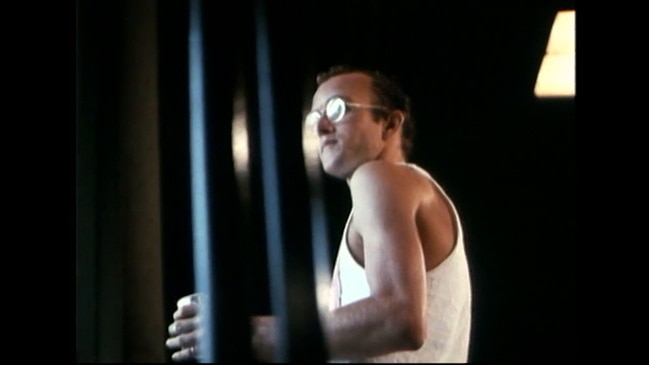
Lifestyle
Don't miss out on the headlines from Lifestyle. Followed categories will be added to My News.
The 1980s art world was completely changed by two US artists — Keith Haring and Jean-Michel Basquiat.
They were radical then and they’re still challenging now in the way they conveyed their political ideas through their signature styles.
Many of their works — about 200 — will be on show at the NGV’s summer blockbuster exhibition, Keith Haring|Jean-Michel Basquiat: Crossing Lines.
Curator Dr Dieter Buchhart has selected 10 of the key works — plus Haring’s work that closes the show — to see at the exhibition, which opens December 1.
JEAN-MICHEL BASQUIAT, UNTITLED 1982
Acrylic and oilstick on wood panel

This is one of the male standing-figure works Basquiat painted on an actual door.
It features Basquiat’s key symbol of the crown to mark it is something special and important.
The standing black male self-empowered figures are ready to fight for their rights.
The reason I have selected this is its one of the most striking works, with the bone in one hand as a weapon and the huge crown on the head of the standing figure.
These works are about black identity.
JEAN-MICHEL BASQUIAT, UNTITLED (WORLD FAMOUS) 1983
Crayon on paper
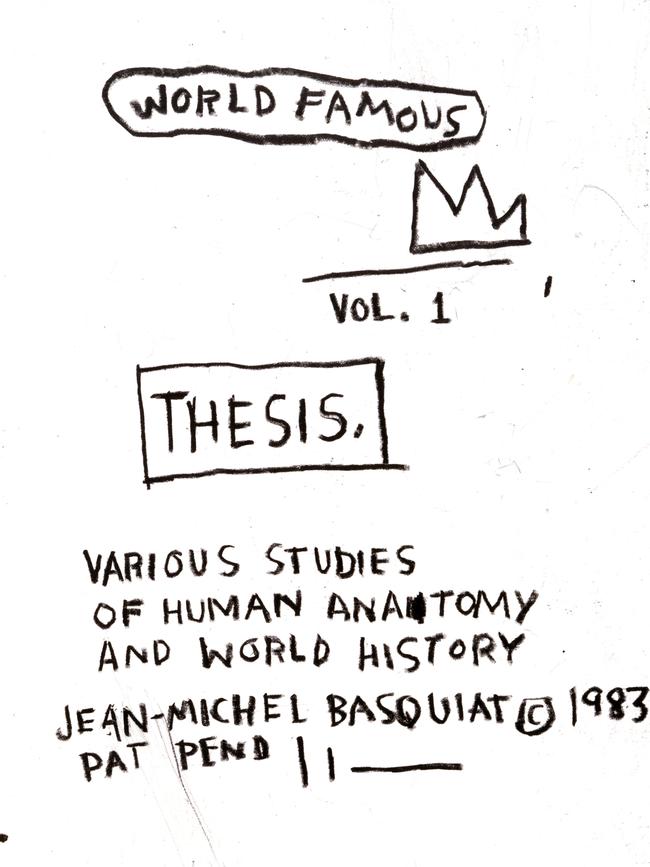

This is an autobiographical work of Basquiat drawing his CV.
It shows how Basquiat worked with words and concrete poetry.
He is wearing a crown as the king of the art scene and he summarises his interest in human anatomy and history.
This drawing is very important because it is a rare CV-like self portrait of Basquiat’s and is reduced to words.
JEAN-MICHEL BASQUIAT, UNTITLED (POLLO FRITO) 1982
Acrylic, oil, and enamel on canvas, diptych

It is one of the most dynamic works from the Annina Nosei period in 1981.
It’s a diptych with black light writing on it.
The head with its halo or crown of thorns has an unbelievable presence.
It is one of the most dynamic and powerful examples of the earlier works of Basquiat.
JEAN-MICHEL BASQUIAT, SELF PORTRAIT 1985
Acrylic, coloured pencil and bottle caps on two wooden panels

It is a silhouette-like self-portrait of Basquiat from the mid-80s.
It is a fascinating work. He pairs the silhouette with beer bottle tops to create texture on the wood construction.
He signed it and titled it Self Portrait on the top of the actual work, which is rare.
JEAN-MICHEL BASQUIAT, ISHTAR 1983
Synthetic polymer paint, wax crayon and photocopy collage on canvas and wood
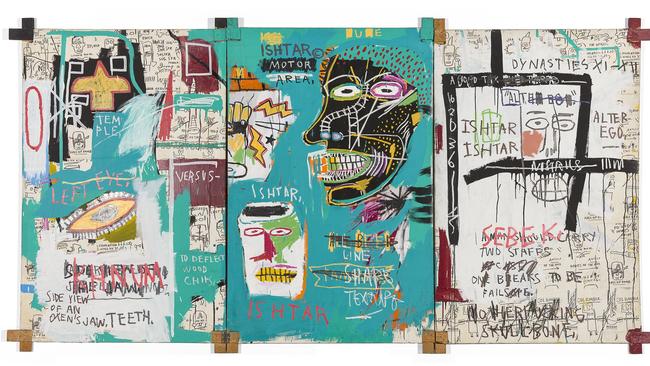
Ishtar is a beautiful three-panelled work. It is a key work from the period of Basquiat’s highest complexity in 1983.
He created a knowledge room filled with references, words, signs and symbols.
The reason it is three panels is that his studio was on the first floor and the works wouldn’t fit in the elevator but the panels added a new element to his work and became a way for him to as contradict the traditional canvas.
KEITH HARING, UNTITLED 1982
Vinyl paint and vinyl ink on vinyl tarpaulin
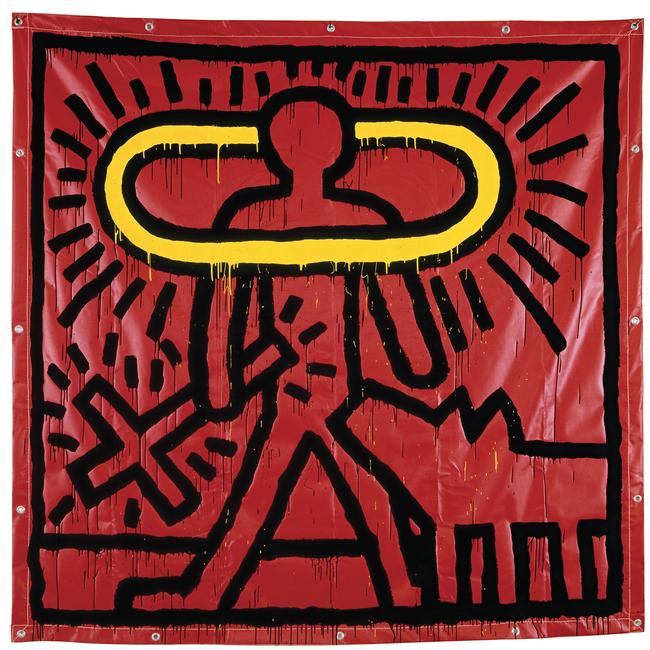
This is a beautiful Haring tarp from 1982 from a series of three, dealing with the strong influence of churches, religion and TV priests in the 1980s.
It is one of my favourite pieces on the one hand because of the painterly line and the way the colour drips and on the other hand for the content and the way he plays around with image words.
KEITH HARING, UNTITLED 1983
Vinyl paint on vinyl tarpaulin

This is a large tarp showing a figure sitting on a caterpillar with its head substituted with a computer.
It’s an amazing work as Haring questions the influence of Silicone Valley and the first personal computers as a danger to humanity. Haring was critical of the influence of computers but was also an early adopter of technology as Steve Jobs personally gifted him an early Apple computer to test in 1984.
KEITH HARING, UNTITLED 1985
Acrylic on canvas

This large canvas depicts one world united by two hands, reminding us that we are one world and we only have one world.
RELATED NEWS:
HOW TO LIVE LIKE A NEW YORKER IN MELBOURNE
HOW HARING TURNED GRAFFITI INTO ARTISTIC TREASURES
CROWD-PLEASING NEW YORK VIBES IN MELBOURNE’S HEART
Haring was very engaged in environmental issues and campaigned against the destruction of our environment.
This work can be viewed as a forerunner of the need to preserve the earth from the threats of climate change.
KEITH HARING, UNTITLED 1982
Enamel colour on steel

This is one of the beautiful works shown in the Tony Sharfazi show of 1982.
It is one of the one of the strong images of Haring’s image words.
The dog jumping through the belly of the stick figure references the assassination of John Lennon and became one of the strongest image words of the artist.
KEITH HARING, UNTITLED (WOOD RELIEF) 1983
Enamel on wood
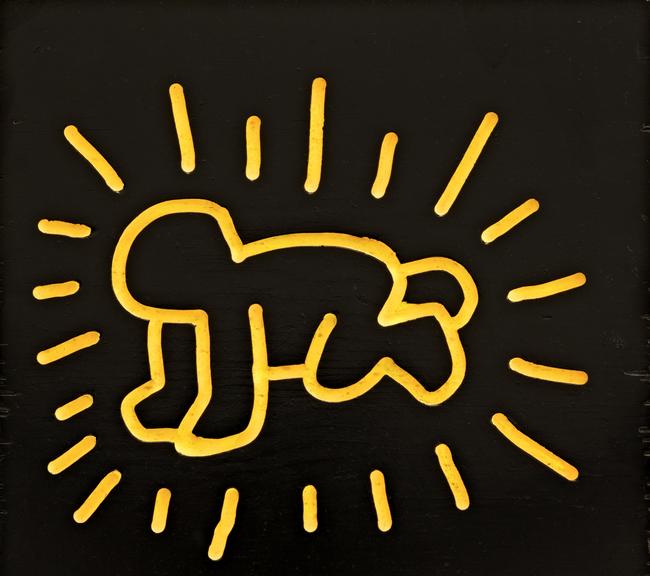
This is one of the most amazing works in the exhibition, showing Haring’s activated baby that acts like a signature.
I love his concentration on the image word in this work. The baby represents the purest form of the human being, unspoilt and open to everything like a blank canvas.
And you wouldn’t want to miss ...
KEITH HARING, PILE OF CROWNS FOR JEAN-MICHEL BASQUIAT 1988
Acrylic on canvas

Pile of Crowns for Jean-Michel Basquiat is one of the most important works in the exhibition.
It brings the two artists together and demonstrates their friendship.
It is Haring’s homage to his dear friend Basquiat who had just died on August 12, 1988.
Haring was writing his obituary for Basquiat for Vogue and he created this gigantic triangle work for Basquiat, showing a pile of crowns with the classic copyright sign.
The crowns represent Basquiat’s signature motif as well as Haring crowning him as the king of the art world.
